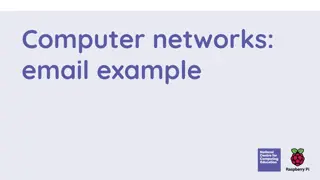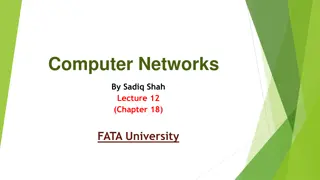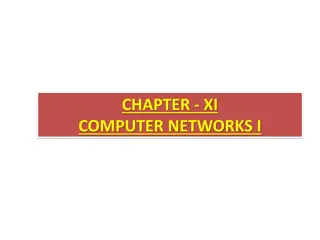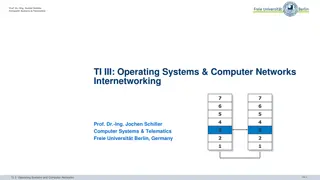Understanding Addressing in Computer Networks
Addressing in computer networks plays a crucial role in efficient communication. Classful addressing, which led to address depletion, has made way for classless addressing and CIDR strategy. In classless addressing, the address space is divided into variable length blocks, allowing for more flexibility and efficiency. By understanding prefix length, slash notation, and how to extract information from an address, network administrators can optimize address allocation and utilization. Embracing these concepts is essential for adapting to modern networking needs and transitioning towards IPv6.
Download Presentation

Please find below an Image/Link to download the presentation.
The content on the website is provided AS IS for your information and personal use only. It may not be sold, licensed, or shared on other websites without obtaining consent from the author. Download presentation by click this link. If you encounter any issues during the download, it is possible that the publisher has removed the file from their server.
E N D
Presentation Transcript
Computer Networks By Sadiq Shah Lecture 13 FATA University
Address Depletion in Classful Addressing The reason that classful addressing has become obsolete is address depletion. Let us think about class A. This class can be assigned to only 128 (27) organizations in the world, but each organization needs to have a single network with 224(16,777,216 nodes) (computers in this single network). Since there may be only a few organizations that are this large, most of the addresses in this class were wasted (unused). The long-range solution has already been devised and is called IPv6 The short-term solution still uses IPv4 addresses, but it is called classless addressing.
Classless Addressing In classless addressing, the whole address space is divided into variable length blocks. The prefix in an address defines the block (network); the suffix defines the node (device). Unlike classful addressing, the prefix length in classless addressing is variable. We can have a prefix length that ranges from 0 to 32. The size of the network is inversely proportional to the length of the prefix. A small prefix means a larger network; a large prefix means a smaller network. Prefix = 18 01101111 10100100 11111111 10111101
Prefix Length: Slash Notation The prefix length, n, is added to the address, separated by a slash. The notation is informally referred to as slash notation and formally as classless interdomain routing or. CIDR (pronounced cider) strategy
Extracting Information from an Address We can find three pieces of information about the block to which the address belongs: the number of addresses, the first address in the block, and the last address. Since the value of prefix length, n, is given, we can easily find these three pieces of information: 1. The number of addresses in the block is found as N = 232 n. 2. To find the first address, we keep the n leftmost bits and set the (32 n) rightmost bits all to 0s. 3. To find the last address, we keep the n leftmost bits and set the (32 n) rightmost bits all to 1s.
Example A classless address is given as 167.199.170.82/27. We can find the above three pieces of information as follows. The number of addresses in the network is 232 n= 25= 32 addresses
The first address can be found by keeping the first 27 bits and changing the rest of the bits to 0s. The last address can be found by keeping the first 27 bits and changing the rest of the bits to 1s.
UNICAST ROUTING PROTOCOLS 1. Routing Information Protocol (RIP), based on the distance-vector algorithm, 2. Open Shortest Path First (OSPF), based on the link-state algorithm, and 3. Border Gateway Protocol (BGP), based on the path- vector algorithm.
Routing Information Protocol (RIP) Hop Count RIP routers advertise the cost of reaching different networks instead of reaching other nodes in a theoretical graph. In other words, the cost is defined between a router and the network in which the destination host is located. The cost is defined as the number of hops, which means the number of networks (subnets) a packet needs to travel through from the source router to the final destination host. In RIP, the maximum cost of a path can be 15, which means 16 is considered as infinity (no connection). For this reason, RIP can be used only in autonomous systems in which the diameter of the AS is not more than 15 hops.
Forwarding Tables A forwarding table in RIP is a three-column table in which the first column is the address of the destination network, the second column is the address of the next router to which the packet should be forwarded, and the third column is the cost (the number of hops) to reach the destination network.
R1 defines that the next router for the path to N4 is R2; R2 defines that the next router to N4 is R3; R3 defines that there is no next router for this path. The tree is then R1 R2 R3 N4.
Open Shortest Path First (OSPF) Open Shortest Path First (OSPF) is also an intradomain routing protocol like RIP. Metric In OSPF, like RIP, the cost of reaching a destination from the host is calculated from the source router to the destination network. However, each link (network) can be assigned a weight based on the throughput, round-trip time, reliability, and so on.
Border Gateway Protocol (BGP), based on the path- vector algorithm Prepare this for coming Viva























